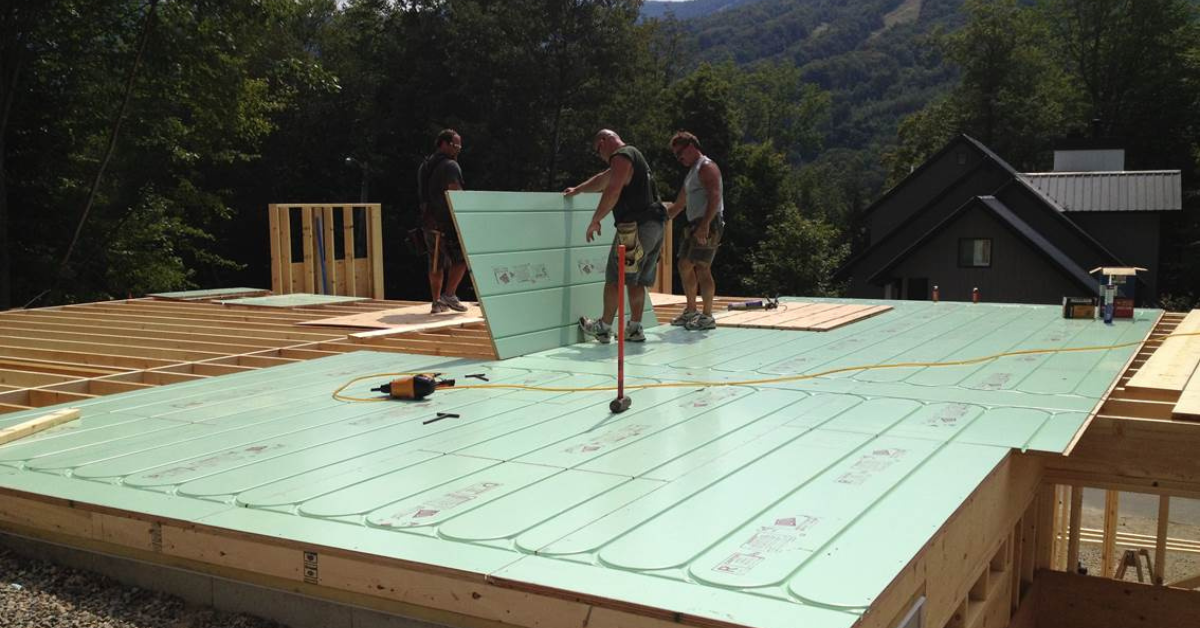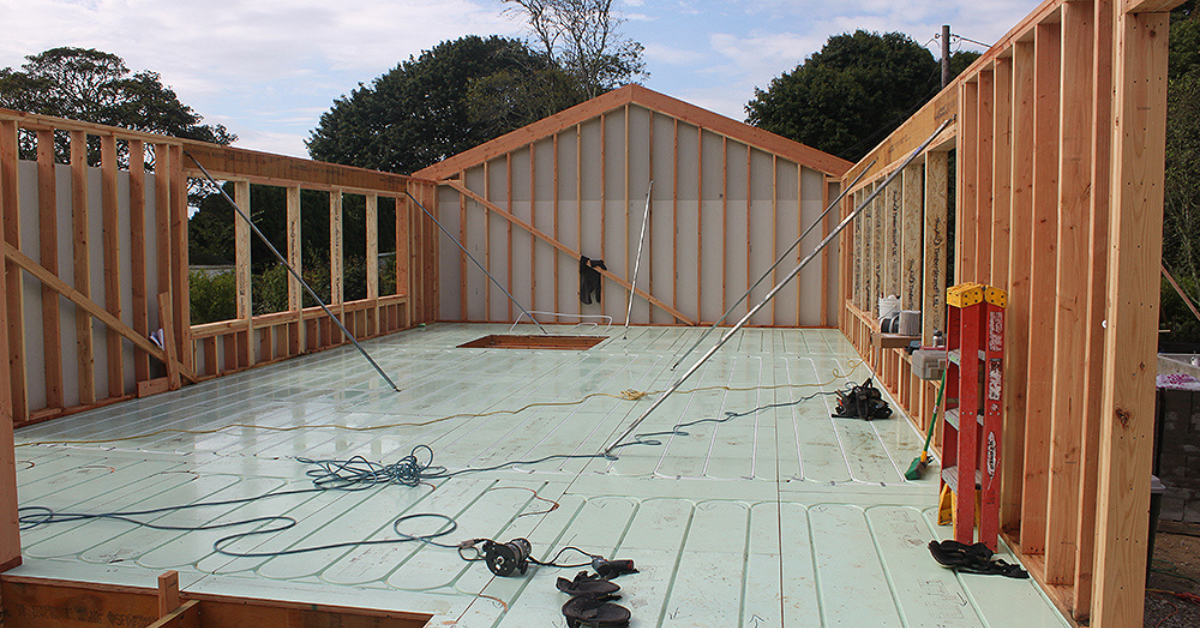The latest trend in heating starts at your feet. Traditional heating options include furnaces, fireplaces, or gas heaters. Unfortunately, there are plenty of downsides to traditional heating, namely the waste of energy and the uneven heat dispersed through a home. Forced air heating that comes in through HVAC vents usually starts from the ceiling, working its way around the room. Since heat rises, though, wouldn’t it make more sense to install heating solutions on the floor?
Experts of the industry unequivocally say yes. Floor heating systems have grabbed the attention of homeowners everywhere. While it feels like a luxurious upgrade, heated floor installation is still very much an option for an everyday home owner. That said, many wonder about the potential safety hazards associated with in-floor heating. Are heated floors safe? We’re exploring a little more on this and additional benefits from radiant floor heating.
![]()
Upgrading Your House from Traditional Heating Systems
Fall season comes around fast and during the hot winter months you may not be looking forward to the chilly winters. However, planning ahead means you’re ready once the cold settles in. Shifting focus from casual shorts and t-shirt wear to socks and sweaters is only half the battle. But imagine being able to walk on your floors without socks and without having to wait for the rooms to warm up?
Installing underfloor heating, admittedly, is no small feat. Remodeling projects takes time, effort, and significant investment. But underfloor heating options not only add a layer of comfort and luxury to a home, but also helps homeowners save on long-term investments, plus it adds resale value, as well.
Installing underfloor heating, admittedly, is no small feat. Remodeling projects take time, effort, and a significant investment. But underfloor heating options not only add a layer of comfort and luxury to a home, but also help homeowners save on long-term investments and add resale value as well. To ensure the success and longevity of your investment, you may also consider incorporating the Acudor A-FPS flood-tight floor panel, which will provide added protection and peace of mind against potential water damage.
What Exactly Are Heated Floors?
Heated floors, otherwise known as radiant floor heating, is a system that utilizes electrical wiring or hydronic tubing underneath the floor to create warmth in your home. The idea is to warm up the floor, allowing heat to rise and ultimately warm the room as well.
The major benefit, of course, is cost savings. According to the U.S. Department of Energy heating systems are the largest home energy expense, accounting for nearly 45% of monthly energy bills. However, traditional heating options waste plenty of energy dispersing hot air from in-wall and ceiling vents. Some common heating options mean choosing between oil, natural gas, electricity, propane and even wood or pellet stoves. However, underfloor or radiant heating options are becoming more accessible for homeowners everywhere.
The benefit of radiant heat is that the heating systems seek to transfer heat directly to objects and people in a room. Instead of blasting air, which is not a good conductor of heat, radiant heat works to eliminate this barrier. But is it safe?
Are Heated Floors Safe?
Before we dive into the safety arena of heated floors, it’s important to consider how each type of radiant heating works and some of the benefits, and drawbacks, with radiant floor heating. Both electric and hydronic floor heating systems do provide heating benefits to make your home comfortable. There are some major differences in how they operate. Here’s a quick rundown.
Electric Radiant Heating Options
Electric radiant heating is generally found in small areas such as a bathroom. Electric radiant warms the floors and can be relatively easy to install and is often done as a DIY project. It’s important to keep in mind that installing electric radiant heat over a wood-framed floor requires placement of fiberglass insulation between joists to improve efficiency and prevent downward heat loss. Installing electric radiant heat over a concrete floor means checking with a manufacturer’s instructions. Some require a layer of foam insulation before a heat cable is installed. Please remember to consider local electricity rates as electric radiant mats can be prohibitive to operate.
Hydronic Radiant Heating Options
Hydronic radiant heating generally requires experts in radiant heat installation. Because hydronic radiant heat can be the sole heat source for a home, upgrading to this type of radiant floor heating is best done when building a new home, building an addition on an existing home, or doing a fairly substantial renovation.
Tubing for hydronic radiant heat can be installed over insulation with a concrete slab being poured on top. Newer methods, like those provided by Warmboard, rely on a thin structural (or overlay) panel installed beneath the flooring. The thinner panel has less mass, allowing the heat to be transferred into the home more quickly than a heavy concrete (or gypsum concrete) pour. Panels with higher conductivity will also transfer the heat more rapidly to the room.
Hydronic systems most commonly use a boiler to operate, though with Warmboard’s new offering a heat pump can work as well. In an existing home heated by hot water radiators or baseboard units, the boiler can usually handle a new hydronic system (though water temperatures for the radiant floor heating system will be significantly lower).
Learn more about how hydronic radiant heating works here.
Are Radiant Floors Safe?
But back to the original question, are these systems safe for homeowners? Simply put, yes.
And Warmboard can help you answer any specific safety concerns in more detail as needed. However, hydronic radiant heat has been around for centuries, and with current technology and applications, it is a completely safe, healthy, efficient and comfortable way to heat your home. Here are some FAQs on radiant floor safety:
Will I Get Shocked?
No. While electric radiant heating wires can definitely have breakage, they are surrounded by protective sheath. There are national safety standards that are met when it comes to reputable electrical radiant heat installation. In short, electric units in the floor will not directly affect surrounding materials to potentially cause harm or hazard.
Will It Get Too Hot?
No. The national requirements limit heating the surface of the floor to 85ºF. But, it’s important to consult with experts in radiant heating installation to ensure proper installation and operation. We understand the process of designing, installing and maintaining hydronic radiant heat systems. We can provide guidance on materials to use in flooring and walls, including insulation requirements and standards that we review and approve before designing your system.
Can Hydronic Radiant Heat Leak Water?
Yes…and No. Much of the concerns surrounding hydronic radiant heating (heated water) is that pipes or tubing may start to leak. This is extremely rare, and can only really occur during the installation process. It most commonly happens when an errant nail punctures a tube during construction. However, before the system is filled with water, the tubing is pressure checked for leaks. If a puncture is found, the hole can be quickly repaired. Once the system has been successfully tested, the tubing is filled with water. At this point, the flooring is installed, and once that tubing is covered, it is safe.
Warmboard Radiant Heating
At Warmboard we are experts in radiant heating. For over 20 years we have helped homeowners find comfort in their homes with energy-efficient systems that provide amazing comfort for homes of all ages.
Whether you’re renovating your existing home or planning a new construction, hydronic radiant heating is one of the top future-proof heating methods to consider.
Warmboard staff is extremely knowledgeable and can help recommend a system for your home to ensure energy savings, performance and comfort. Contact us to get started on your Warmboard project today.
Related blog posts:

